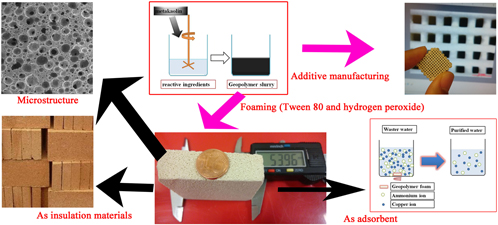Crossref Citations
This article has been cited by the following publications. This list is generated based on data provided by
Crossref.
Conoscenti, Gioacchino
Carfì Pavia, Francesco
Ciraldo, Francesca Elisa
Liverani, Liliana
Brucato, Valerio
La Carrubba, Vincenzo
and
Boccaccini, Aldo R.
2018.
In vitro degradation and bioactivity of composite poly-l-lactic (PLLA)/bioactive glass (BG) scaffolds: comparison of 45S5 and 1393BG compositions.
Journal of Materials Science,
Vol. 53,
Issue. 4,
p.
2362.
Alghamdi, Hussam
and
Neithalath, Narayanan
2018.
Novel synthesis of lightweight geopolymer matrices from fly ash through carbonate-based activation.
Materials Today Communications,
Vol. 17,
Issue. ,
p.
266.
Shao, Ning-ning
Zhang, Yan-bo
Liu, Ze
Wang, Dong-min
and
Zhang, Zuo-tai
2018.
Fabrication of hollow microspheres filled fly ash based foam geopolymers with ultra-low thermal conductivity and relative high strength.
Construction and Building Materials,
Vol. 185,
Issue. ,
p.
567.
Zhang, Peng
Dong, Zhiyuan
Ran, Yuanming
Xie, Hualin
Lu, Yun
and
Ding, Shimin
2018.
Preparation and photocatalytic application of AgBr modified Bi2WO6 nanosheets with high adsorption capacity.
Journal of Materials Research,
Vol. 33,
Issue. 23,
p.
3953.
Bai, Chengying
and
Colombo, Paolo
2018.
Processing, properties and applications of highly porous geopolymers: A review.
Ceramics International,
Vol. 44,
Issue. 14,
p.
16103.
Bai, Chengying
Ni, Tao
Wang, Qiaoling
Li, Hongqiang
and
Colombo, Paolo
2018.
Porosity, mechanical and insulating properties of geopolymer foams using vegetable oil as the stabilizing agent.
Journal of the European Ceramic Society,
Vol. 38,
Issue. 2,
p.
799.
Kaewapai, Kannikar
Lertcumfu, Narumon
Jaita, Pharatree
Manotham, Supalak
Tunkasiri, Tawee
Malasri, Pruchya
and
Rujijanagul, Gobwute
2019.
Preparation and Characterization of Ceramic Waste-Based Geopolymer Ceramic Composites for Substrate Culture Application.
Key Engineering Materials,
Vol. 798,
Issue. ,
p.
194.
Alghamdi, Hussam
and
Neithalath, Narayanan
2019.
Synthesis and characterization of 3D-printable geopolymeric foams for thermally efficient building envelope materials.
Cement and Concrete Composites,
Vol. 104,
Issue. ,
p.
103377.
Yan, Shu
Zhang, Fanyong
Liu, Jingjing
Ren, Bo
He, Peigang
Jia, Dechang
and
Yang, Jinlong
2019.
Green synthesis of high porosity waste gangue microsphere/geopolymer composite foams via hydrogen peroxide modification.
Journal of Cleaner Production,
Vol. 227,
Issue. ,
p.
483.
Kaddami, Asmaa
and
Pitois, Olivier
2019.
A physical approach towards controlling the microstructure of metakaolin-based geopolymer foams.
Cement and Concrete Research,
Vol. 124,
Issue. ,
p.
105807.
Le, Van Su
2019.
THERMAL CONDUCTIVITY OF REINFORCED GEOPOLYMER FOAMS.
Ceramics - Silikaty,
p.
365.
Kastiukas, Gediminas
Zhou, Xiangming
Wan, Kai Tai
and
Castro Gomes, João
2019.
Lightweight Alkali-Activated Material from Mining and Glass Waste by Chemical and Physical Foaming.
Journal of Materials in Civil Engineering,
Vol. 31,
Issue. 3,
Gao, Huan
Liu, Hao
Liao, Libing
Mei, Lefu
Lv, Guocheng
Liang, Liming
Zhu, Guodian
Wang, Zejie
and
Huang, Danlan
2019.
Improvement of performance of foam perlite thermal insulation material by the design of a triple-hierarchical porous structure.
Energy and Buildings,
Vol. 200,
Issue. ,
p.
21.
Demir, Funda
and
Derun, Emek Moroydor
2019.
Modelling and optimization of gold mine tailings based geopolymer by using response surface method and its application in Pb2+ removal.
Journal of Cleaner Production,
Vol. 237,
Issue. ,
p.
117766.
Bumanis, Girts
Novais, Rui M.
Carvalheiras, João
Bajare, Diana
and
Labrincha, João A.
2019.
Metals removal from aqueous solutions by tailored porous waste-based granulated alkali-activated materials.
Applied Clay Science,
Vol. 179,
Issue. ,
p.
105147.
Shi, Caijun
Qu, Bo
and
Provis, John L.
2019.
Recent progress in low-carbon binders.
Cement and Concrete Research,
Vol. 122,
Issue. ,
p.
227.
Luukkonen, Tero
Heponiemi, Anne
Runtti, Hanna
Pesonen, Janne
Yliniemi, Juho
and
Lassi, Ulla
2019.
Application of alkali-activated materials for water and wastewater treatment: a review.
Reviews in Environmental Science and Bio/Technology,
Vol. 18,
Issue. 2,
p.
271.
Novais, Rui M.
Pullar, Robert.C.
and
Labrincha, João A.
2020.
Geopolymer foams: An overview of recent advancements.
Progress in Materials Science,
Vol. 109,
Issue. ,
p.
100621.
Yu, Mengting
Xu, Zihan
Ji, Na
Dai, Lei
Xiong, Liu
and
Sun, Qingjie
2020.
Inhibition of normal and waxy corn starch retrogradation by sodium borohydride.
International Journal of Biological Macromolecules,
Vol. 153,
Issue. ,
p.
341.
Rao, P. R.
Momayez, M.
Runge, K. A.
and
Muralidharan, K.
2020.
Recent Developments in Thermally Insulating Materials Based on Geopolymers—a Review Article.
Mining, Metallurgy & Exploration,
Vol. 37,
Issue. 4,
p.
995.




